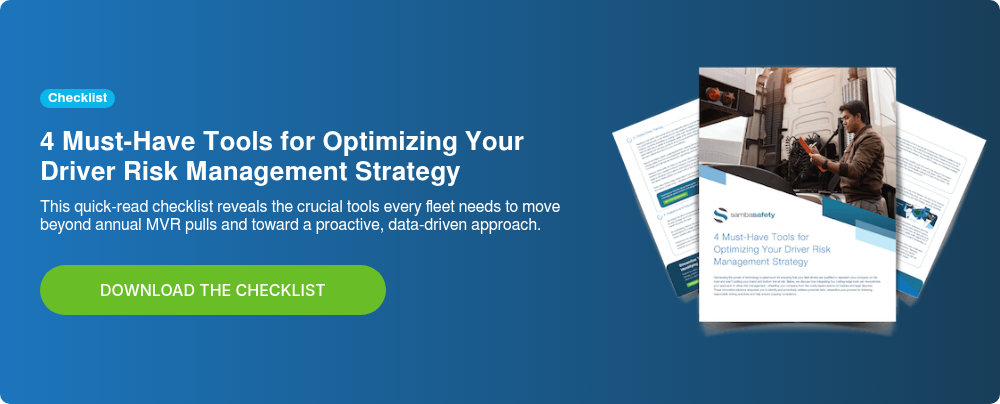MVRs & Canadian Driving Records: Alternatives for Ensuring Driver Eligibility and Enforcing Compliance Across Borders

Managing a fleet that operates across both Canada and the United States (U.S.) poses unique challenges for companies striving to maintain a high level of safety and compliance. One significant hurdle is ensuring that all drivers, regardless of their location, possess valid and up-to-date drivers’ licenses. This is traditionally done by reviewing both American Motor Vehicle Records (MVRs) and Canadian driving records (also known as driver abstracts).
In this blog, we explore the well-known challenges that companies face as they attempt to bridge the gaps across borders and assess driver eligibility throughout their entire driver population. We also introduce a comprehensive approach that addresses and solves these hiccups in your risk management strategy.
Free Checklist: 4 Must-Have Tools for Optimizing Your Driver Risk Management Strategy
The Dangers of Invalid and Suspended Drivers’ Licenses
Ineligible drivers pose significant challenges for companies managing fleets and present great risks for others sharing the road.
Did you know that individuals driving with suspended licenses make up approximately 3 to 5% of the total drivers on the road at any given time (SambaSafety Insights)? Additionally, 19% of all driving fatalities in the U.S. involve individuals with invalid licenses.

Changes in license status and eligibility also significantly impact the likelihood of a future claim. According to our insights:
- Driving with a suspended license increases the likelihood of a claim by 56%
- Having an expired license increases the likelihood of a claim by 48%
This reality underscores the gravity of the issue and the need for stringent monitoring and intervention measures for company drivers.
4 Challenges with Managing Cross-Border Fleets and Reviewing Canadian Driving Records
1. Managing and Enforcing Multiple Safety Policies
Enforcing safety policies across a fleet operating in both the U.S. and Canada is a well-known challenge for many companies. Beyond the distinct regulatory frameworks, licensing procedures and record-keeping systems that make it challenging to implement a uniform safety policy, companies are also limited by the data that’s available to them. Very few driver risk management and monitoring solutions can provide license status data for drivers in all 50 U.S. states and all Canadian provinces, causing downstream impacts on employers attempting to hold drivers to the same standards and safety policy.
The lack of harmonization often results in inconsistencies in enforcement, leaving companies in a precarious position where adherence to safety standards may vary based on the driver’s location. This poses a risk to the overall safety of the fleet and opens the door to potential legal and compliance issues.
2. Costly Canadian Driver Records
Obtaining a Canadian abstract to review a driver’s license status also comes with a hefty price tag. For example, certified abstracts in Ontario cost $18. Add to that the sluggish turn-around times, and you’ve got a financial and operational challenge on your hands. In the fast-paced world of fleet management where timely decisions matter, the cost and delays create a significant hurdle.
3. Limited Visibility
As companies struggle to obtain and review this critical license data across their fleets, concerning gaps in the visibility of drivers’ license statuses form. The risk of overlooking changes in license statuses increases, potentially leaving companies exposed to unforeseen liabilities.
4. The Use of Disparate Systems
As companies attempt to close these visibility gaps, many go down a convoluted path of using multiple systems and tapping into various data sources to secure the right information for their entire driver population. This fragmented approach, while an attempt to ensure comprehensive oversight, inadvertently becomes a stumbling block in the efficient management of cross-border fleets.
Juggling disparate systems introduces inefficiencies that can have a ripple effect across the entire operational workflow. The complexity arises not just from the diverse regulatory landscapes of the U.S. and Canada, but also from the varied technological infrastructures that underpin these systems. It’s like trying to assemble a puzzle with pieces from different sets – the result is a picture that lacks coherence and clarity.
In addressing this challenge, companies require a comprehensive solution that transcends geographical boundaries, offering a unified and thorough monitoring system to guarantee the continuous compliance of their entire cross-border fleet.
The Solution: Comprehensive License Status Monitoring for U.S. and Canadian Drivers
To effectively tackle the complex landscape of cross-border fleet management, companies are turning to continuous license status monitoring as a proactive solution. This innovative technology ensures ongoing and automated alerts of any changes to a driver’s license status in both Canada and the U.S., bridging the visibility gap between routine driver record reviews.
Traditionally, manual, periodic reviews risk leaving companies unaware of critical changes, allowing drivers to continue operating with invalid licenses. License status monitoring provides timely alerts to employers as soon as issues arise, empowering swift intervention to rectify the situation.
Let’s delve into the amplified benefits of this comprehensive monitoring approach.
Consistency in Policy Enforcement
With license status monitoring, companies can hold all drivers, regardless of their location, to the same high standards and safety policies. The system allows for the enrollment and tracking of licenses across borders without exceptions, fostering a unified risk management strategy. This consistency ensures compliance and maximizes safety across the entire driver population, mitigating the likelihood of future violations, crashes and costly litigation.
Efficiency & Cost-Savings
License status monitoring offers a cost-effective alternative to traditional methods of manually ordering driving records, giving companies access to critical driver’s license data for a fraction of the cost. By identifying license status changes promptly, companies can circumvent the need for solely relying on expensive abstracts and MVR pulls with sluggish turn-around times. The result is a streamlined and cost-efficient process that keeps operational expenses in check.
Comprehensive Visibility
License status monitoring doesn’t just stop at cost-effectiveness; it extends to ensuring a comprehensive monitoring footprint across both countries. This means all drivers, regardless of their location, are consistently monitored for valid licenses. The ongoing insights into license status changes empower companies to swiftly pull ineligible drivers off the road, acting as a proactive measure to prevent potential incidents.
Centralized Risk Management
The implementation of license status monitoring brings with it the advantage of centralized risk management. Now, companies can monitor their entire fleet of Canadian and U.S. drivers through a unified platform. This integrated approach streamlines the entire workflow, from enrollment into monitoring to prompt alerts, targeted training, timely intervention and advanced risk insights.
Additional Tips for Optimizing Your Driver Risk Management Strategy
Managing a cross-border fleet requires a proactive and comprehensive approach. By embracing solutions that incorporate data from both Canadian and U.S. drivers, companies can ensure the safety and eligibility of their drivers, streamline their operational efficiency and reduce costs.
To learn more about the importance of streamlining your processes, download our free checklist, 4 Must-Have Tools for Optimizing Your Driver Risk Management Strategy.




-min.png)